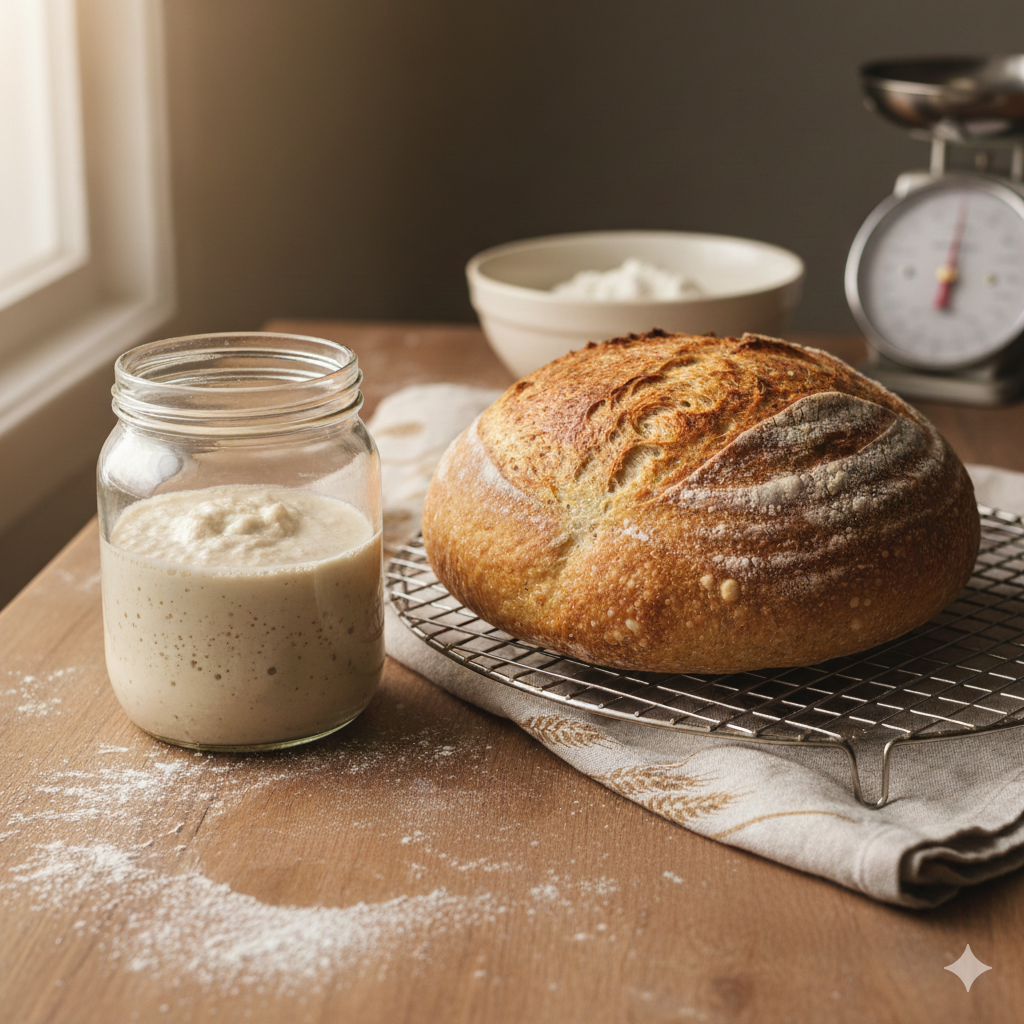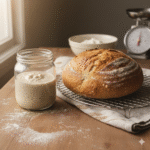Want a reliable sourdough recipe with starter? This easy, beginner-friendly loaf uses an active 100% hydration starter and simple steps for a crusty, flavorful bread.
Sourdough Recipe With Starter — Quick Overview
This sourdough recipe with starter yields one medium–large boule and assumes a 100% hydration active starter (equal weights flour:water). Use the same-day schedule if you need it tonight, or the overnight retard for deeper flavor and easier slicing.
How this Sourdough Recipe With Starter Works (timings & hydration)
Count the starter into the total hydration: this recipe sits around ~70% hydration overall. Autolyse boosts gluten development with minimal kneading, stretch-and-folds build structure, and the fridge retard step deepens flavor while slowing fermentation.
Ingredients (makes 1 standard boule / 1 large loaf)
Notes: This recipe assumes your starter is 100% hydration (equal parts flour+water by weight). The starter weight is included in the totals below so the math matches the dough hydration.
- 450 g bread flour
- 50 g whole wheat flour (optional; you can use 500 g bread flour instead)
- 300 g water (room temperature)
- 100 g active sourdough starter (100% hydration — fed, bubbly)
- 10 g fine salt (about 1.75 tsp)
Yields: 1 large loaf (about 800–900 g finished dough).
Method for this sourdough recipe with starter— simple step-by-step
- Feed and check your starter (4–8 hours before or overnight). Use a bubbly, active starter. It should double (or show lots of bubbles) within a few hours after feeding.
- Autolyse (30–60 minutes). In a large bowl, mix the 300 g water with the 500 g total flour (450 g bread flour + 50 g whole wheat if using) until there are no dry patches. Cover and rest 30–60 minutes.
Why: autolyse hydrates flour and helps gluten development. - Add starter + salt (5 minutes). Add 100 g starter and 10 g salt. Mix until incorporated — squeeze and fold the dough until homogeneous. Cover.
- Bulk fermentation with stretch-and-folds (2–4 hours at ~75°F / adjust for temp).
- Do 4 sets of stretch-and-folds every 20–30 minutes during the first 1.5–2 hours. To stretch-and-fold: wet hands, lift one side and fold over; rotate bowl and repeat 4×.
- After the last fold, let dough rest undisturbed until it has increased by ~20–40% and shows bubbles at the surface. (Warmer temps shorten time; cooler temps lengthen it.)
- Shape: Turn dough onto a lightly floured surface, pre-shape into a round, rest 15–20 minutes, then final shape into a tight boule. Place seam-side up in a floured banneton (or bowl lined with linen).
- Final proof: Room temp 1–2 hours until puffy (Option A) or fridge 8–16 hours (Option B).
- Preheat oven + bake: Preheat oven to 475°F (245°C) with a Dutch oven inside for at least 45 minutes. Score the loaf, transfer dough seam-side down into hot Dutch oven, cover, bake 20 minutes covered, then reduce to 450°F (230°C) and bake 20–25 minutes uncovered until deep brown and hollow-sounding. Internal temp ~205–210°F when done.
- Cool: Let cool at least 1 hour before slicing to finish crumb set.
Tips for Success: Common Issues with a Sourdough Recipe With Starter
- Starter not bubbly? Feed 1–3 times, keep warm, and wait until it reliably doubles before using.
- Dense crumb? Try slightly longer bulk fermentation, increase hydration a touch, or avoid over-handling during shaping.
- Flat or collapsed loaf? You may have overproofed — shorten the final proof or move to a cooler proof (fridge).
- Too sour? Reduce fridge time or bake sooner after shaping.
- Difficulty scoring? Use a sharp lame or razor and score confidently — quick shallow cuts can help until you get a feel for it.
Troubleshooting & quick fixes
- Starter not bubbly? Feed 2–3 times or wait until it doubles before using.
- Too dense crumb? Try longer bulk fermentation (warm place), gentler shaping, or slightly higher hydration.
- Flat loaf after scoring? You may have overproofed — shorter final proof next time.
- Too sour? Shorten retard time or bake sooner after final proof.
Easy Sourdough Recipe With Starter — No-Fail Everyday Loaf
Equipment
- 1 Banneton
- 1 Dutch Oven
Ingredients
- 450 g bread flour
- 50 g whole wheat flour optional; you can use 500 g bread flour instead
- 300 g water room temperature
- 100 g active sourdough starter 100% hydration — fed, bubbly
- 10 g fine salt about 1.75 tsp
Instructions
- Feed and check your starter (4–8 hours before or overnight). Use a bubbly, active starter. It should double (or show lots of bubbles) within a few hours after feeding.
- Autolyse (30–60 minutes). In a large bowl, mix the 300 g water with the 500 g total flour (450 g bread flour + 50 g whole wheat if using) until there are no dry patches. Cover and rest 30–60 minutes.
- Why: autolyse hydrates flour and helps gluten development.
- Add starter + salt (5 minutes). Add 100 g starter and 10 g salt. Mix until incorporated — squeeze and fold the dough until homogeneous. Cover.
- Bulk fermentation with stretch-and-folds (2–4 hours at ~75°F / adjust for temp).
- Do 4 sets of stretch-and-folds every 20–30 minutes during the first 1.5–2 hours. To stretch-and-fold: wet hands, lift one side and fold over; rotate bowl and repeat 4×.
- After the last fold, let dough rest undisturbed until it has increased by ~20–40% and shows bubbles at the surface. (Warmer temps shorten time; cooler temps lengthen it.)
- Option A — Same day schedule: Bulk ferment ~3–4 hours total, then shape and final proof 1–2 hours (or until ~80% rise), bake.
- Option B — Overnight retard (recommended for flavor): After initial bulk and folds (1.5–2 hours), shape lightly and place in a floured banneton, cover, and refrigerate overnight (8–16 hours). Bake next day from cold.
- Shape: Turn dough onto a lightly floured surface, pre-shape into a round, rest 15–20 minutes, then final shape into a tight boule. Place seam-side up in a floured banneton (or bowl lined with linen).
- Final proof: Room temp 1–2 hours until puffy (Option A) or fridge 8–16 hours (Option B).
- Preheat oven + bake: Preheat oven to 475°F (245°C) with a Dutch oven inside for at least 45 minutes. Score the loaf, transfer dough seam-side down into hot Dutch oven, cover, bake 20 minutes covered, then reduce to 450°F (230°C) and bake 20–25 minutes uncovered until deep brown and hollow-sounding. Internal temp ~205–210°F when done.
- Cool: Let cool at least 1 hour before slicing to finish crumb set.
Notes
Troubleshooting & quick fixes
- Starter not bubbly? Feed 2–3 times or wait until it doubles before using.
- Too dense crumb? Try longer bulk fermentation (warm place), gentler shaping, or slightly higher hydration.
- Flat loaf after scoring? You may have overproofed — shorter final proof next time.
- Too sour? Shorten retard time or bake sooner after final proof.
Q: Do I need to make a starter first?
No — this recipe is designed for people who already have an active starter. If you don’t: click here for a starter recipe with instructions.
Q: Can I use a refrigerated starter?
Q: What is 100% hydration starter?
A: A starter fed with equal weights of flour and water (e.g., 50 g flour + 50 g water). If your starter is different, hydration and water additions will need small tweaks.
Further reading (examples to add as outbound links if you want)
King Arthur Baking, Serious Eats sourdough techniques, and The Perfect Loaf are excellent resources for starter care and advanced tips.
https://www.kingarthurbaking.com/recipes/sourdough-starter-recipe
If you tried this sourdough recipe with starter, please leave a rating and a photo — I love seeing crumb shots! Want an overnight schedule, or a smaller/large loaf version? Tell me below.

